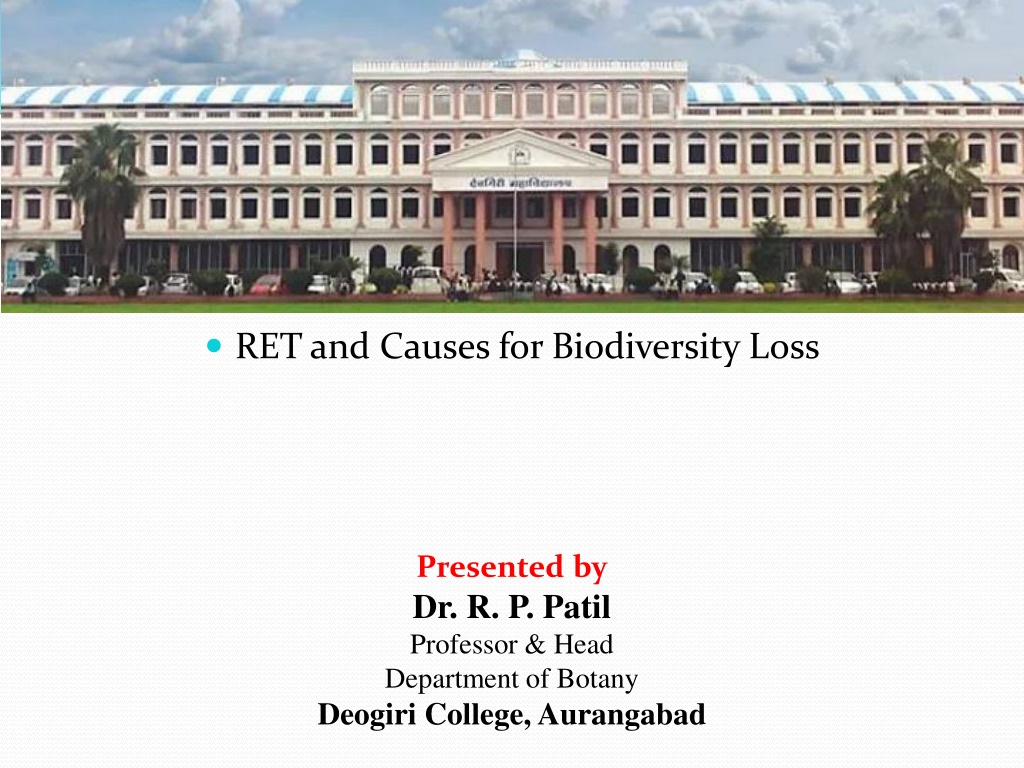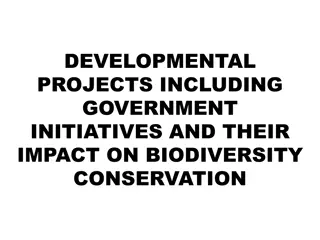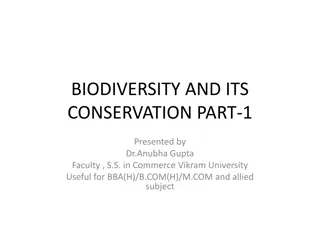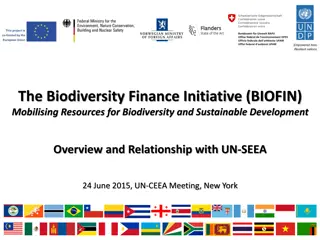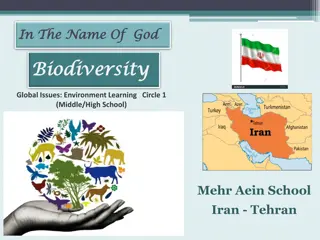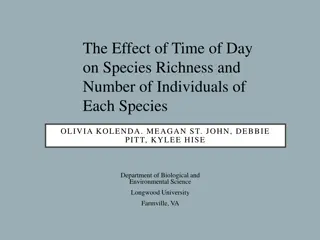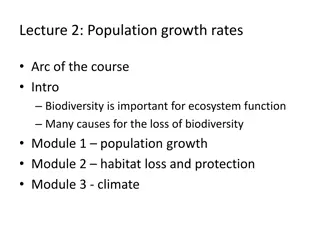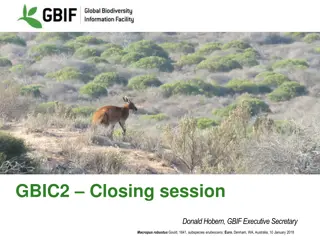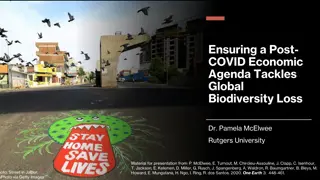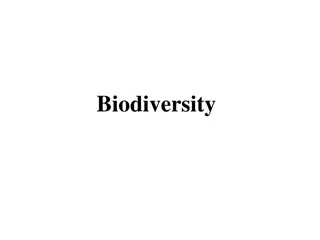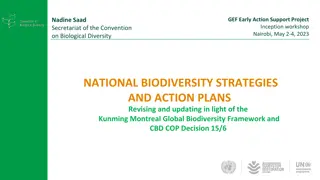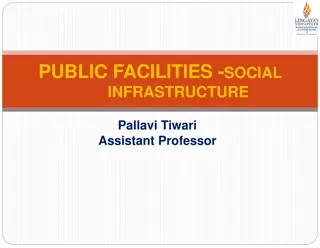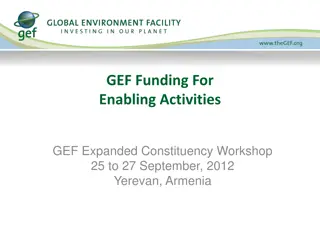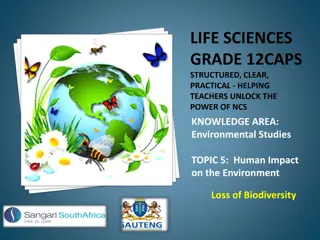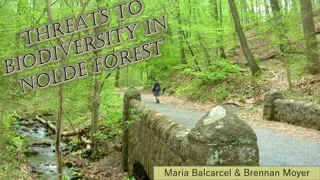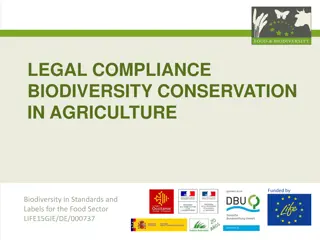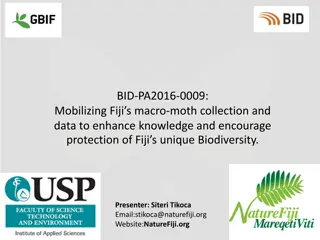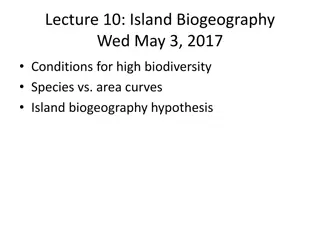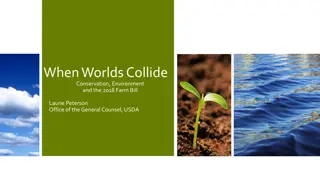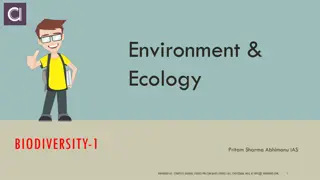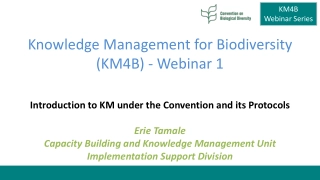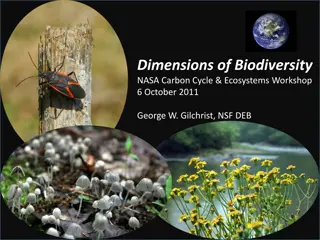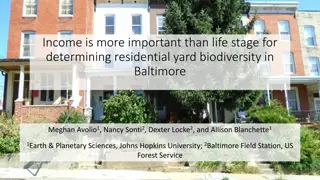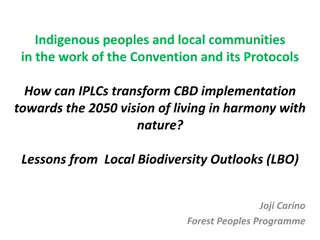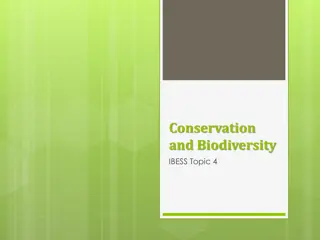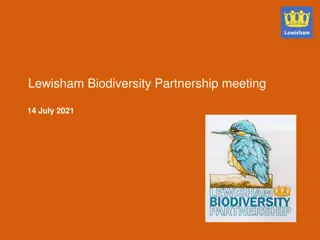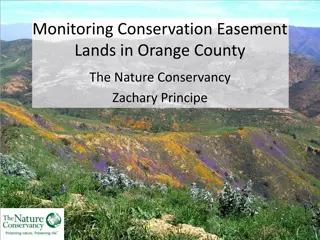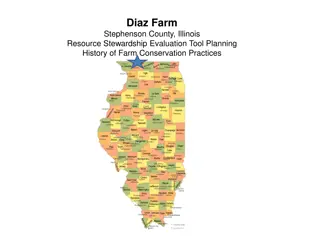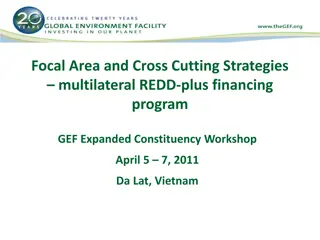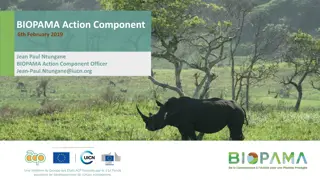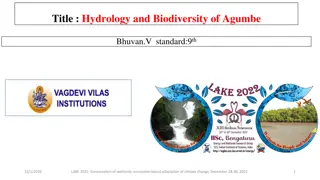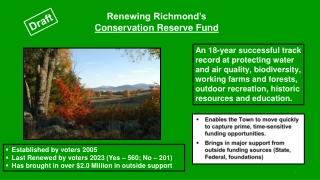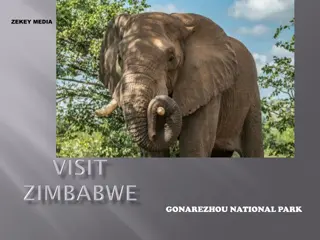Biodiversity Richness and Conservation in India
India, a mega diversity country, boasts a vast array of plant and animal species across different biogeographic zones. With impressive forest coverage and substantial species diversity, India plays a crucial role in global biodiversity conservation efforts. The country's unique ecosystems, rich heritage of biological diversity, and traditional agricultural practices contribute to its status as a biodiversity hotspot.
Download Presentation

Please find below an Image/Link to download the presentation.
The content on the website is provided AS IS for your information and personal use only. It may not be sold, licensed, or shared on other websites without obtaining consent from the author. Download presentation by click this link. If you encounter any issues during the download, it is possible that the publisher has removed the file from their server.
E N D
Presentation Transcript
RET and Causes for Biodiversity Loss Presented by Dr. R. P. Patil Professor & Head Department of Botany Deogiri College, Aurangabad
Diversity & Endemism of India with World. Plant groups No of species India(endemic) World 850(-) World No % of India to World(endemic) Viruses Bacteria Algae Fungi Lichens Liverworts Mosses Pteridophytes Gymnosperms Angiosperms 8,050 10.6(-) 900,000 6500(1924) 14,500(3500) 2021(466) 845(260) 1980(678) 1200(193) 48(10) 17,500(5725) 40,000 7,2000 13,500 7,500 7,000 10,000 650 2,50,000 16.3(16) 20.1(24) 15.0(23) 11.3(31) 28.3(34) 12.0(16) 7.4(20.8) 7.0(32.7) 350,000 100,00,000 20,000 9,000 9,000 1,2000 650 3,00,000
Biodiversity In India: India is the seventh largest country in the world and Asia's second largest nation with an area of 3,287,263 square km. The Indian mainland stretches from 8 4' to 37 6' N latitude and from 687' to 97 25' E longitude Figure 1. It has a land frontier of some 15,200 kms and a coastline of 7,516 km (Government of India, 1985). India's northern frontiers are with Xizang (Tibet) in thePeoples Republic of China, Nepal and Bhutan. In the north-west, India borders on Pakistan; inthe north-east, China and Burma; and in the east, Burma. The southern peninsula extends into the tropical waters of the Indian Ocean with the Bay of Bengal lying to the south-east and the Arabian Sea to the south-west. Although India has only 2.4 per cent of the world s land area, India has 23.39% of its geographical area under forest its share of the global species diversity is an impressive 8.1 per cent. That is what makes our country one of the 17 mega diversity countries of the world. India is also one of the eight primary centers of origin of cultivated plants and has a rich agricultural biodiversity. India is known for its rich heritage of biological diversity, having already documented over 91,000 species of animals and 45,500 species of plants in its ten biogeographic regions. Nearly 6,500 native plants are still used prominently in indigenous healthcare systems. Thousands of locally-adapted crop varieties, grown traditionally since ancient times, and nearly 140 native breeds of farm livestock, continue to thrive in its diversified farming systems. The country is recognized as one of the eight Vavilovian Centres of Origin and Diversity of Crop Plants, having more than 300 wild ancestors and close relatives of cultivated plants still growing and evolving under natural conditions
India Represents Two Realms, Five Biomes, Ten Bio-geographic Zones and Twenty-five Bio-geographic provinces. Realms: Biogeographic realms are large spatial regions within which ecosystems share a broadly similar biota. A realm is a continent or sub-continent sized area with unifying features of geography and fauna & flora. The Indian region is composed of two realms. They are: the Himalayan region represented by Palearctic Realm and the rest of the sub-continent represented by Malayan Realm In world,Eight terrestrial biogeographic realms are typically recognised. They are Nearctic Realm Palaearctic Realm Africotropical Realm Indomalayan Realm Ocenaia Realm Australian Realm Antarctic Realm Neotropical Realm
The five biomes of India are: Tropical Humid Forests Tropical Dry or Deciduous Forests (including Monsoon Forests) Warm deserts and semi-deserts Coniferous forests and Alpine meadows.
India World Heritage Site Sl. No . 1 Name of WH Site State Location Year of Notificat ion 2014 Area (sq.km) Great Himalayan National Park Conservation Area Western Ghats Himachal Pradesh 905.4 2 Maharashtra, Goa, Karnataka, Tamil Nadu and Kerala Uttarakhand 2012 7,953.15 3 Nanda Devi andValley of Flowers National Parks Sundarbans National Park Kaziranga National Park Keoladeo National Park Manas Wildlife Sanctuary 1988 630.00 87.50 1,330.10 429.96 28.73 391.00 4 5 6 7 West Bengal Assam Rajasthan Assam 1987 1985 1985 1985
Trans Himalaya 1A: Himalaya Ladakh Mountains 1B: Himalaya Tibetan Plateau 1C: Trans Himalaya Sikkim 2A: Himalaya North West Himalaya(Kashmir) 2B: Himalaya West Himalaya(HP) 2C: Himalaya Central Himalaya 2D: Himalaya East Himalaya(Assam and other area) 3A: Desert Thar 3B: Desert Kutch 4A: Semi-Arid Punjab Plains 4B: Semi-Arid Gujarat Rajputana 5A: Western Ghats Malabar Plains 5B: Western Ghats Western Ghats Mountains 6A: Deccan Peninsular Central Highlands 6B: Deccan Peninsular Chotta Nagpur 6C: Deccan Peninsular Eastern Highlands 6D: Deccan Peninsular Central Plateau 6E: Deccan Peninsular Deccan South 7A: Gangetic Plain Upper Gangetic Plains 7B: Gangetic Plain Lower Gangetic Plains 8A: Coasts West Coast 8B: Coasts East Coast 8C: Coasts Lakshadweep 9A: North-East Brahmaputra Valley 9B: North-East North East Hills 10A: Islands Andaman 10B: Islands Nicobars The Himalaya The Indian Desert The Semi-Arid The Western Ghats The Deccan Peninsula The Gangetic Plains The Coasts Northeast India Islands
Kingdoms India World % Species in India/World PROTISTA Algae 2,500 40,000 6.25 Fungi 23,000 47,000 48.94 Lighens 2,450 17,000 11.41 PLANTAE 2,843 16,000 17.77 Bryophytes Pteridophytes 1,022 13,000 7.86 8.53 Gymnosperms 750 64 Angiosperms 19,530* 2,50,000 7.00
Global 200 ecoregion list is most helpful to conservation efforts at a regional scale: Chota Nagpur dry forests (India) Eastern Deccan Plateau moist forests (India) Eastern Himalayan alpine meadows (Bhutan, China, India, Myanmar, Nepal) Eastern Himalayan broadleaf and conifer forests (Bhutan, China, India, Myanmar, Nepal) Himalayan subtropical pine forests (Bhutan, India, Nepal, Pakistan) Naga-Manipuri-Chin hills moist forests (India) Northeast India-Myanmar pine forests (India, Myanmar) Rann of Kutch flooded grasslands (India, Pakistan) Southwestern Ghats moist forests (India) Sundarbans mangroves (Bangladesh, India) Terai-Duar savannas and grasslands (Bhutan, India, Nepal) Tibetan Plateau steppe (Afghanistan, China, India, Pakistan, Tajikistan) Western Himalayan temperate forests (Afghanistan, India, Nepal, Pakistan)
India is one of the seventeen mega diversity nations of the world due to the following reasons: (i) It has 7.3% of the global fauna and 10.88% of global flora as per the data collected by Ministry of Environment and forest. (ii) It has 350 different mammals, 1200 species of birds- 453 different reptiles, 182 amphibians and 45,000 plants spices. In terms of species richness, India ranks seventh in mammals, ninth in birds and fifth in reptiles. In terms of endemism of vertebrate groups, India s position is tenth in birds with 69 species, fifth in reptiles with 156 species and seventh in amphibians with 110 species. (iii) It has 50,000 known species of insects which include 13,000 butterflies and moths. (iv) It has 10 different biogeographical regions and 25 biotic provinces having varieties of lands and species. (v) In addition to geographical distribution, geological events in the land mass provide high level of biological diversity. (vi) Several crops arose in the country and spread throughout the world. India s share of crops is 44% as compared to the world average of 11%. (vii) There is wide variety of domestic animals like cows, buffaloes, goats, sheep, pigs, horses etc. (viii) The marine biota includes sea weeds, fishes, crustaceans, molluses, corals, reptiles etc. (ix) There are a number of hot spots (namely Eastern Ghats, Western Ghats, North Eastern hills etc.).
THREATENED PLANT SPECIES Some 10,00,000 organisms estimated, Scientific names for 2,70,000 known in plant species Threatened Plant Committee Commission of IUCN (TPCSSC) of the Survival Service An average of 1 in 10 of the species are Endangered or Threatened. Out of total 2,50,000 Vascular Plants in world 25,000 are endangered. During Next 30-40 yrs. nearly 60,000 Plant spp. may be in danger of Extinction or serious genetic erosion.
Threats to biodiversity Habitat destruction Pollution Species Introductions Global Climate Change Exploitation
Habitat (natural home) Destruction: Human population growth and encroachment into forest lands,Itmay result from clearing and burning forests, draining and filling of wetlands, converting natural areas for agricultural or industrial uses, human settlements, mines, building of roads, bridges, railway tracks, dams, mining, sand excavation, rock-granite-marble cutting lead to habitat loss and other developmental projects. This way the natural habitats of organisms are changed or destroyed. Apart from the direct loss of species during the development activities, the new environment is unsuitable for the species to survive. Over exploitation reduces the size of the population of a species and may push it towards extinction.
Climate Change and Desertification Climate change, on account of a buildup of greenhouse gases in the atmosphere leading to global warming, poses another significant threat to biodiversity, ecosystems, and the goods and services they provide. There are indications that the projected changes in temperature and CO2 concentration may alter growth, reproduction and host- pathogen relationships in both plants and animals. It is believed that the ecosystems with undiminished species diversity, and species with their genetic diversity intact, are likely to be in a much better position to face the impact of climate change.
Habitat fragmentation: With increased population, the habitats are fragmented into pieces by roads, fields, canals, power lines, towns etc. The isolated fragment of habitats restricts the potential of species for dispersal and colonization. In addition, the habitat fragmentation also brings about microclimatic changes inlight, temperature, wind etc.
Over exploitation: The natural resources are over exploited to meet growing rural poverty, intensive technological growth and globalization of economy. All these factors together may be responsible for the extinction of a number of species. Humans have always depended on nature for food and shelter, but when need turns to greed , it leads to over- exploitation of natural resources. Excessive cutting of trees, overgrazing, collection of firewood, poaching of wild animals for skin ,tigers, crocodile, snakes, deer, bear, ivory etc. all result in gradual loss of species.
Introduction/ Invasion of exotic/ Alien species: When alien species are introduced unintentionally or deliberately for whatever purpose, some of them turn invasive and cause decline or extinction of indigenous species. Parthenium hysterophorus(Congress grass- a tropical American weed), Argemone, Lantana camara (an American weed), Water hyacinth (Eichornea)Prosopis juliflora, Cytisus scoparius, Euphorbia royleanaMimosa species, Eupatorium glandulosum,Eichhornia crassipes, Mikania micrantha, Ulex enropaeus,has invaded many of the vacant areas in cities, towns and villages
Pollution: The most dreaded factor inducing loss of biodiversity is environmental pollution which include Air pollution, acid rain destroy forests. Water pollution kills fishes and other aquatic plants and animals. Toxic and hazardous substances drained into waterways kill aquatic life. Oil spills kill coastal birds, plants and other marine animals. Plastic trash entangles wildlife. It is easy to see how pollution is a big threat to biodiversity. Mobile radiation..
Population growth and poverty: The population explosion has created pressure on forest land and resources, and this causes deforestation. Deforestation accentuates soil erosion (soil degradation). Roots of trees and plants bind the soil particles and regulate the flow of water, thus saving soil from erosion. Deforestation makes soil vulnerable to wind and water erosion. In this practice a patch of land is cleared, vegetation is burned, and the ash is mixed with the soil thus adding nutrients to the soil. This agricultural practice has become unsustainable due to rapid increase in population pressure in the forested areas.
Major Causes of loss of Biodiversity (Only because of Human interference) HYDROPOWER PROJECTS Involving large water diversion, inundation or other major transformation of aquatic or terrestrial natural areas, leading to habitat reduction or modification, with resultant forced movement of fauna into new areas and likely violation of carrying capacity there and permanent loss of flora. ; IRRIGATION AND OTHER WATER SUPPLY PROJECTS : That may remove water, drain wetland habitats or eliminate essential watering sources; kills aquatic flora and fauna. INDUSTRIAL PROJECTS : Involving air, water, or soil pollution; LARGE-SCALE LOSS OF HABITATS : Due to mining and mineral exploration, rehabilitation, roads, rails, bridges, dams, urbanization etc.; CONVERSION OF BIOLOGICAL RESOURCE : For industrial fuels or feedstock s.
Threats to Biodiversity 1. TEMPERATE REGION 2. TROPICAL REGION Shifting cultivation Overgrazing Plantation 3. INDIVIDUAL SPECIES Lack of Pollination Pest and Diseases Critically Low Population Collecting for horticulture & Biodiversity Selective logging Forest Fire Use of Biocides, Herbicides etc. Forestry Practices (Monoculture) Regeneration of Scrub. Dam construction and flooding of areas Air and water pollution Tourism Mining, refineries etc. Pressure from introduced species. Weed cutting
International Union for Conservation of Nature and Natural Resources. IUCN Red List Endangered species IUCN Red List refers to a specific category of threatened species, and may include critically endangered species. IUCN Red List of Threatened Species uses the term endangered species. Under the IUCN Categories and Criteria, endangered species is between critically endangered and vulnerable. Also critically endangered species may also be counted as endangered species and fill all the criteria
World scenario of Threatened species in percentage. File:IUCN Red List 2007.svg The percentage of species in several groups which are listed as critically endangered(Dark brown), endangered(light brown), or vulnerable (yellow brown) .
Extinct (EX) No individuals remaining. Extinct in the Wild (EW) Known only to survive in captivity, or as a naturalized population outside its historic range. Critically Endangered (CR) Extremely high risk of extinction in the wild. Endangered (EN) High risk of extinction in the wild. Vulnerable (VU) High risk of endangerment in the wild. Near Threatened (NT) - Likely to become endangered in future. Least Concern (LC) - Lowest risk. Does not qualify for a more at risk category. Widespread and abundant taxa are included in this category. Data Deficient (DD) - Not enough data to make an assessment of its risk of extinction. Not Evaluated (NE) - Has not yet been evaluated against the criteria
Not Evaluated(NE): A species when it is has not yet been evaluated against the criteria. This species has less information related with distribution.For some species, not enough data is available to assign a Red List Category or the species has not yet had its Red List status evaluated. In these cases, species are attributed to this category as Not Evaluated (NE). Data Deficient(DD): A taxon is Data Deficient when there is inadequate information to make a direct, orindirect, assessment of its risk of extinction based on its distribution and/or population status. The appropriate data on abundance and/or distribution are lacking. Data Deficient is therefore not a category of threat.
Vulnerable(VU): A taxon is Vulnerable when the best available evidence indicates that it meets any of the criteria for Vulnerable, and is as a result considered to be facing a high risk of extinction in the wild.Taxa likely to move into the endangered category in near future if the causal factors continue to operate. Taxa or all populations in this category mostly decrease insize because of overexploitation, extensive destruction of habitat or environmental disturbances. Taxa with populations that are still abundant but under threat from severe adverse factors throughout their distribution range. The other criteria include 50% decline in last 20 years; < 20,000 km2occupancy or < 2,000 km2in fragmented populations; 10,000 individuals or subpopulation of 1,000 mature individuals.
Endangered(EN): Species in danger of extinction (within a few decades) and whose survival is unlikely if the causal factors continues to operate,the whose numbers have been reduced to a critical level or whose habitats have been so drastically reduced that they are deemed to be in immediate danger of extinction. Also included are taxa that may now be extinct even though seen in the wild in the past 50 years. The other criteria are 50% decline in the last 10 years; <5,000 km2area of occupancy or <500 km2in fragmented areas; 2,500 individuals or subpopulation of 250 mature individuals. A taxon is endangered when the best available evidence indicates that it meets any of the criteria for Endangered and promote into critically endangered and is as a result considered to be facing a very high risk of extinction in the wild.
Critically Endangered (CR): The category Critically Endangered (CR) includes species which are depleted with a rapid rate that will face an extremely high risk of extinction in the wild in the immediate future. These are characterized by 80% decline in the last 10 years, 100 km2occupancy or 10 km2in fragmented areas. A species is Critically Endangered when the best available evidence indicates that it meets any of the criteria for Critically Endangered and is as a result considered to be facing an extremely high risk of extinction in the wild if the conservation steps are not being taken.
Extinct in Wild(EW): Extinct in the wild should be used to refer to species lost in their natural habitat or in wild state, while living under cultivation or controlled (dubbed by IUCN as EW).A taxon is Extinct in the Wild when it is known only to survive in protected atmosphere, in captivity or as a naturalized population (or populations) well outside the past range. A taxon is presumed Extinct in the Wild when exhaustive surveys resulted No individuals were recorded. This may lead to obstacle for the species under its evolution and adaptability. There is lot of possibilities that in near future this species will turn into Extinct category.
Extinct (EX): Species not definitely located in the wild during the past fifty years but which may survive in cultivation. Some authors suggest that Extinct should denote those taxa that have been totally lost.A taxon is Extinct when there is no reasonable doubt that the last individual has died. A taxon is presumed Extinct when exhaustive surveys in known and/or expected habitat, at appropriate times (diurnal, seasonal, annual), throughout its historic range have failed to record an individual. Surveys should be over a time frame appropriate to the taxon's life cycle and life form.
Near Threatened (NT): Species in this category are close to qualifying for, or are likely to qualify for, a threatened category in the near future.A taxon is Near Threatened when it has been evaluated against the criteria but does not qualify for Critically Endangered, Endangered or Vulnerable now, but is close to qualifying for or is likely to qualify for a threatened category in the near future. Least Concerned (LC): Species in this category are generally widespread and abundant. A taxon is Least Concern when it has been evaluated against the criteria and does not qualify for Critically Endangered, Endangered, Vulnerable or Near Threatened. Widespread and abundant taxa are included in this category. Beside these above nine categories in the IUCN Red List system, ranging from Least Concern to Extinct there are some terms are also used in categorization of plants which are in threatened situations. Indeterminate (I): Species considered definitely to be endangered, vulnerable or rare but for which information is insufficient to categorically assign them to any of these three categories. Rare (R): Taxa with small populations that are not endangered or vulnerable at present but are at risk are included under this category. A species may be rare because of restricted geographical range, high habitat specificity and small local population size, or thinly scattered over a more extensive range, or due to a combination of two or more of these characteristics. Rare species have a population of less than 20,000 individuals. Some species are naturally rare and have never occurred in greater numbers, yet they are able to maintain these numbers. Other species become rare through man s action or other natural forces.
THREATENED PLANT SPECIES Some 10-20 Million organisms estimated, Scientific names for 2,70,000 known in plant species Threatened Plant Committee of the Survival Service Commission of IUCN (TPCSSC) An average of 1 in 10 of the species are Endangered or Threatened. In next 30 years as many as half of the species on the earth could die if this extinction continues. - Dr. Leaky Sixth Extinction believes that 50% of earths species will vanish within 10 years Out of total 2,50,000 Vascular Plants in world 25,000 are under endangered category. It is estimated that Everyday, 100 plant and animal species are being lost due to deforestation. During Next 30-40 yrs. nearly 60,000 Plant spp. may be in danger of Extinction or serious genetic erosion.
Name of Plant Name of the Family Aspergaceae Asclepiadacea e Asclepiadacea e Amaryllidacea e Liliaceae Asclepidaceae Locality Conservation status Medicinal Endangered Sr. No 01 Asparagus jacquemonti Baker Ceropegiamahabalei,Hemadri. Pune Junnar 02 Ceropegiapanchganiensis. Blatt.exMcCann Crinum eleonoraeBlatt. & McCann Mahabaleshw ar Mahabaleshw ar Maharashtra Shivneri Endangered 03 Rare 04 05 DipcadiursulaeBlatt. Frereaindica, Delz. Endangered Critically endangered Rare 06 HabenariapanchganiensisSantapau&Ka padia Ipomoea clarkei, Hook Orchidaceae Satara 07 Convolvulacea e Leguminoceae Apiaceae Leguminosae Simaroubacea e Moraceae Boraginaceae Lecythidaceae Liliaceae Euphorbiaceae Pune Western Ghats Konkan Katraj Ghats Konkan Pune Rare 08 09 10 11 Mimosa hamata, Willd. PimpinellakatrajensisRao&Hemadri Acacia ferrugineaDC.Prodr. Ailanthus excelaRoxb. Endangered Rare Rare Medicinal 12 13 14 15 16 Artocarpus incises(Thunb.) L. f. CordiadichotomaForst. f. CouroupitaguianensisAubl. Iphigenia magnificaAnsari & Rolla Rao JoannesiaprincepsVell. Pune Konkan Pune Raigad Rare Medicinal Medicinal Vulnerable Vulnerable 17 University Mumbai Khayaanthotheca, (welw)C.DC. Meliaceae Vulnerable 18
Lagarstomiaflos-Reginae, Retz. Lythraceae South Konkan Pune Endangered 19 Morindacitrifolia, Linn Rubiaceae Rare 20 Nathopoditesnimmuniana (Graham) Mabb. Radermacheraxylocarpa(Roxb.) K. Schum. SaracaindicaLinn Icacinaceae Mahabales hwar Pune Endangered 21 Bignoniaceae Endemic 22 Leguminoceae Konkan Endangered 23 Sesbaniagrandiflora. (L.) Pers. Papilionaceae Nagar Endangered 24 SterculiaurensRoxb. Sterculiaceae Kandol Pune Konkan Endangered 25 Strychonusnuxvomica Linn Longaniaceae Rare 26 TerminalianeotalialaCapuron Combretaceae Konkan Rare 27 Wrightiaarborea(Dennst.) Mabb. Apocynaceae Pune University Khandala Rare 28 Gymnema khandalense(Roxb.) R.Br. Asclepiadaceae Rare 29 Smilax ovalifoliaRoxb Liliaceae Bhimashan kar Western Ghats Endangered 30 TylophoraindicaBurm. (f.) Merill Ascepiadaceae Endangered 31
IF YOU PLAN FOR ONE YEAR, PLANT RICE PLANT IF YOU PLAN FOR TEN YEARS, PLANT A TREE IF YOU PLAN FOR 100 YEAR EDUCATE THE PEOPLE
References: Chowdhery H.J, and Murthy S. K. Bishen Singh Mahendra Pal Singh pub,Dun. Ahmedullah.M.& Nayar M.P. 1986. Endemic pl of Ind region, Vol I,BSI, Culcutta. Arora R.K.1991 Plant diversity..IBPGR, New Delhi. Arora R.K. & Nayar E.R.1984 Wild relatives of crop plants...NBPGR, New Delhi. Naik. V.N. 1998. Flora of Marathawada, Amrut Pub Aurangabad. Naik V.N. 1980. Taxonomy of Angiosperms.Tata Mc Graw Hill pub.
